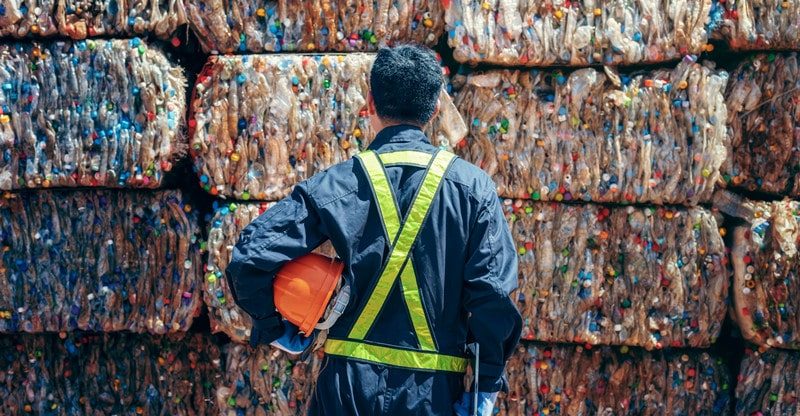Price Movement and Growing Opportunities for Global Recycled Plastic Market
1. Global historical price movement of recycled plastics
Global Recycled plastics, particularly Recycled Polypropylene (R-PP), Recycled High-Density Polyethylene (R-HDPE), Recycled Polyethylene Terephthalate (R-PET), and Recycled Linear Low-Density Polyethylene (R-LLDPE), have witnessed mixed market sentiments prior to the Coronavirus pandemic.
If we take Recycled Polyethylene Terephthalate (R-PET), the product’s market differs from region to region. The market of this product in Germany and the U.S. rose in 2018 from 2017 and again fell in 2019; however, the Chinese market of this product appears to be contrary during the same time frame, as the market appears to be moderate till 2018, and has gone up in 2019.
Because of the breakout of Coronavirus, almost all upstream and downstream industries across the world had to be shut down, so the prices of these products saw a drastic downfall in 2020. However, from late 2020 till the end of 2021, the prices started to experience drastic growth as the spreading of this virus was being curbed, and businesses started resuming their operations.
2. The conflict between Russia and Ukraine has been affecting the virgin plastics markets in Europe and has paved the way for the recycled plastics market to grow.
Europe is a major producer and consumer of plastics like Polypropylene (PP), Linear Low-Density Polyethylene (LLDPE), and the conflict is affecting the prices of products that contain plastic.
Packaging sectors, notably pulp and paper, have reported serious concerns over rising energy prices and reduced supplies of raw materials. While Russia’s role in PE exports is small, its impact on Europe’s energy supply is much greater, meaning the war in Ukraine and sanctions on Russia and Belarus could also significantly impact the plastic packaging industry.
Russia’s invasion of Ukraine on oil and gas supplies could impact European polyethylene (PE) production, exports, and imports, while imports from other countries may fill the deficit.
In addition to the polymers needed to make plastic parts and assemblies and the steel needed to mold plastics, the companies also face a shortage of pallets used to transport goods. Ukraine is a major producer of wooden pallets, supplying about fifteen million pallets per year to Europe.
The market of recycled plastics like R-PET, R-HDPE, R-LLDPE, and R-PP was also down due to some of the above-discussed factors, and as on 28th October 2022, the R-PET prices (flakes) in Germany stood at USD 1,882 per MT on FD – Hamburg basis.
However, the market of these products is likely to bounce back, as several companies are coming up with various announcements with regards to recycling plastics in recent times, like setting up of new plants, acquisition, and expansion of recycling facilities, etc., which could probably enhance the market of these plastics in Europe in the years and months to come.
Even multiple plastics and packaging industries are moving towards using Recycled Linear Low-Density Polyethylene (R-LLDPE) and Recycled Polypropylene (R-PP) for their production purposes. Several Food and beverage companies have also taken a call to go with the usage of Recycled Polyethylene Terephthalate (R-PET) for packing edible and other consumer products.
Because of these announcements, the supply and availability of recycled plastics (R-PET, R-HDPE, R-LLDPE, and R-PP) in inventories and markets are anticipated to grow drastically in the upcoming months.
3. Enhanced demand from downstream companies is driving the markets of recycled plastics in Asian countries
According to research conducted by the World Bank Group in 2021, more than 75% of recyclable plastics in the Philippines, Thailand, and Malaysia, like Polyvinyl Chloride (PVC), Polyethylene Terephthalate (PET), etc. are wasted. This represents an untapped business opportunity for companies offering recycled PVC and other recycled plastics in these countries.
Because recycled plastics like Recycled Polypropylene (R-PP), Recycled Polyethylene Terephthalate (R-PET), have equivalent properties to virgin plastics, their use in automotive, textile, packaging, construction and other industries is rapidly accelerating. Furthermore, the governments of China and India are enacting strict regulations on plastic recycling to reduce environmental pollution and landfill plastic waste, which drives the market.
These strict regulations have a huge possibility for pushing the markets of recycled plastics like R-LLDPE and R-HDPE to grow in these nations in the coming months, which are moderate at present.
The strong automotive and food and beverage industries in Japan, South Korea, China, and India are creating a huge demand for recycled plastics. These recycled plastics like R-PP and R-PET are often used to make sustainable food packagings such as bottles, containers, and films.
The demand for recycled plastics, particularly for Recycled Polypropylene (R-PP) in the automotive industry, is driving the growth of the recycled plastics market. The increasing amount of plastic waste in the environment has led manufacturers to turn to produce recycled plastics, which are used in large quantities in various industries. Increased vehicle production will create lucrative opportunities for recycled plastics.
As a result, Recycled Polypropylene (R-PP) prices grew in China in October, and as of 28th October 2022, this product’s injection molding grade price was at USD 900 per MT on (spot) ex – Shenzhen basis.
As the need for recycled plastics is enhancing, and there has been active growth in recycling companies in India and China, the availability of these recycled plastics (R-PP, R-PET) is expected to be more in the months to come.
4. The market for recycled plastics in the U.S. is declining; however, it may bounce back.
In recent years, it has been an industrial buyer’s market for all recyclable raw materials. In many cases, recycled feedstocks must also compete with virgin feedstocks.
For example, the High-Density Polyethylene (HDPE) industry has seen excess capacity for virgin resin over the past two years as manufacturers were able to secure better deals for virgin HDPE over recycled one, the market of recycled HDPE (R-HDPE) was down, so far and as on 28th October 2022, the cost of this product stood at USD 2,000 per MT for natural pellets grade on FOB-Houston basis.
Recycling plastics like Linear Low-Density Polyethylene (LLDPE) and Polypropylene (PP) is expensive and requires many infrastructures, equipment, water, and energy.
According to current estimates, plastic recycling rates in the United States range from 5% to 6%. Only two types of plastic bottles and jugs are actually accepted at most municipal recycling facilities, and plastic is more frequently burned than recycled.
PET is typically used for beverage bottles, and HDPE is frequently used for packaging milk jugs and personal care items. PET recycling rates are estimated to be 20.9%, while HDPE recycling rates are 10.3%. The recycling rate for all other types of plastic is less than 5%.
However, growth in the U.S. recycled plastics market is expected to boom in the coming years as companies such as Reckitt Benckiser, Unilever, Procter & Gamble, and PepsiCo are also working on using recycled plastics in their product packaging, and many companies are coming up with more announcements regarding chemical recycling of plastics, which has the ability to process hard to recycle plastics.
So, the supply of recycled plastics in the U.S., like R-PET, R-HDPE, etc., has got a high chance of increasing in the forthcoming months and years.
Advanced plastic recycling technologies have significantly expanded the waste plastic market by helping to remove more plastic from the environment and put it into productive use. The plastics industry continues to evolve, generating new innovative ideas for recycled plastics. Advanced recycling technologies could process millions of tonnes of plastic waste annually.
5. Concerns over the environment are likely to drive market sentiments in favor of recycled plastics globally in the future.
While plastic has been recycled since the 1970s, the amount recycled varies by plastic type and application. The recycling of packaging materials has expanded rapidly in many countries over the past few decades.
Advances in technologies and systems for collecting, sorting, and reprocessing recyclable plastics are creating new opportunities for recycling, with the potential to divert the bulk of plastic waste from landfills to recycling with collective action by the public, industry, and governments for decades to come.
Growing concerns about plastic pollution, harmful emissions from petrochemicals, and depleting crude oil reserves are driving the demand for recycled plastics. The global production of recycled plastic materials like Recycled Linear-Low-Density Polyethylene (R-LLDPE), Recycled Polyethylene terephthalate (R-PET), Recycled Polypropylene (R-PP), and Recycled High-Density Polyethylene (R-HDPE), primarily comes from Asia – Pacific and Southeast Asia, North America, and Europe.
The increasing use of recycled plastics in many industries, such as textile, automotive, packaging, electrical and electronics, and building and construction, is expected to increase the global demand for recycled plastics.
As concerns about the use of plastics grow, so does the demand for alternatives to traditional plastics. As the pace of innovation and new product development accelerates, manufacturers in the market are shifting their focus to using recycled plastics like R-LLDPE and R-PP, as they reduce the carbon footprint associated with the manufacturing process.
Companies are continually developing product lines that use recycled materials to address concerns about the toxic effects of plastic waste.
About ChemAnalyst
ChemAnalyst is a subsidiary of Techsci Research, which was established in 2008, and has been providing exceptional management consulting to its clients across the globe for over a decade now.
For the past four years, ChemAnalyst has been a prominent provider of Chemical commodity prices in more than 15 countries. We are a team of more than 100 Chemical Analysts who are committed to provide in-depth market insights and real-time price movement for 300+ chemical and petrochemical products. ChemAnalyst has reverberated as a preferred pricing supplier among Procurement managers and Strategy professionals worldwide.
On our platform, we provide an algorithm-based subscription where users can track and compare years of historical data and prices based on grades and incoterms (CIF, CFR, FOB, & EX-Works) in just one go.
The ChemAnalyst team also assists clients with Market Analysis for over 1200 chemicals including assessing demand & supply gaps, locating verified suppliers, choosing whether to trade or manufacture, developing Procurement Strategies, monitoring imports and exports of Chemicals, and much more.
The users will not only be able to analyze historical data for past years but will also get to inspect detailed forecasts for the upcoming years. With access to local field teams, the company provides high-quality, reliable market analysis data for more than 40 countries.
ChemAnalyst is your one-stop solution for all data-related needs. We at ChemAnalyst are dedicated to accommodate all of our world-class clients with their data and insights needs via our comprehensive online platform.
To know more about us. Please visit: https://www.chemanalyst.com/



